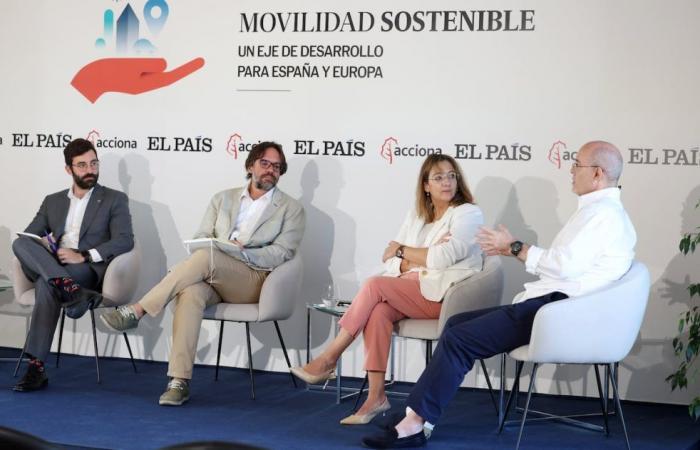The data is alarming. One in five annual deaths in the world is due to air pollution. Transportation, which generates more than 25% of CO2 emissions, contributes 70% of these toxic gases from the roads. This sector is the main source of nitrogen oxides and the second of carbon monoxide and particles. And urban areas contribute 23% of CO2 emissions from transportation. The data is only a reflection of the footprint we leave with our movements, which have their effect on health and the environment, and are influenced by various factors such as demographics, land use and the local economy. Balancing the current quality of life, attracting businesses, investments with reducing traffic in sensitive and congested areas are crucial challenges for the future.
Although electric mobility is a viable reality, both for individuals and for various sectors such as logistics and transportation, its progress has not yet come to fruition. To show a button. Last week, the executive president of Seat / Cupra, Wayne Griffiths, presented his resignation as president of the Spanish Association of Automobile and Truck Manufacturers (Anfac), due to the “inaction of the Government in favor of electrification.” It is “a wake-up call” that must be kept in mind,” acknowledged Jordi Hereu, the Minister of Industry and Tourism. “It is true that billions of euros have been invested [en la electrificación de la movilidad]but it is no less true that the processes are slow and often do not fit well with the demands of the private sector,” said Daniel Toledo, deputy director of CincoDías, during an event organized by EL PAÍS and Acciona under the title Sustainable mobility: an axis of development for Spain and Europe.
The challenge of transforming mobility is monumental. It is not only about changing combustion units for electric ones, but it involves redefining public transport (making it available to everyone), transfiguring the streets to give more space to other types of units such as bicycles and investing more in sustainable infrastructure. This includes the creation of a network of charging points for electric vehicles, the promotion of intermodality that combines various means efficiently. In essence, it is a comprehensive rethinking of how we move. “It is necessary to develop and deploy cleaner, more efficient and accessible systems that minimize the environmental impact and maximize social benefits,” highlighted Paloma Aba Garrote, director of the European Executive Agency for Climate, Infrastructure and the Environment (Cinea), during the meeting held in Madrid.
Investments
With an investment of 2.8 billion euros through the Horizon Europe program, the European Commission intends to support the challenge of mobility and thus expand its commitment to the development of new technologies, the deployment of electric vehicles and green transport systems, Aba explained. Club. “The research, innovation and infrastructure programs represent a significant investment in the future of Spain and the EU.” Cinea leads key initiatives such as 2Zero (Towards Zero-emission Road Transport) and CCAM (Cooperative, Connected and Automated Mobility) to move towards zero-emission road transport and improve connected and automated mobility. Furthermore, with the BAT4U partnership it seeks to establish a sustainable value chain for electromobility batteries.
Under the mission of smart and carbon-neutral cities, Cinea also promotes projects such as Civitas, which demonstrate sustainable urban mobility solutions. In Madrid, the European Civitas Scale Up project implements some measures such as bidirectional charging stations for electric vehicles and chargers in underground parking lots. “By supporting the development of cleaner, more efficient and accessible European transport systems, we can create a healthier society,” said Aba Garrote. While the electric vehicle is an important part of the solution, experts noted that it is not the only one.
A combination of different modes of transport is needed, such as public, bicycle and carpooling. But it is the electrification of private units that captures a good part of the discussions in the sector. Especially because of the aid it receives, such as the Moves III Program, which will end on July 31. “The Moves III Program [con un presupuesto de 1.200 millones de euros] “It is still valid for those who consider purchasing an electric vehicle,” said Joan Groizard Payeras, general director of the Institute for Energy Diversification and Saving (IDAE), which manages the project. “It is evident that the bet [del Gobierno] for the electric vehicle has been fundamental since 2018, being guaranteed by the Law on Climate Change and Energy Transition,” he stressed. But the issue of sustainable mobility in Spain, according to Groizard Payeras, has been the subject of a constant and often polarized debate in the political sphere.
“Over the decades, we have seen how political decisions have contradicted fundamental technical criteria for sustainable mobility. “It is frustrating to see how European funds are returned or rejected due to decisions that, from a technical perspective, do not seem efficient or effective for urban displacement,” he highlighted. Mobility is a growing concern. And, frequently, decisions are made not only to achieve or maintain power, but also to reverse previous policies without considering the general interest, said Álvaro Fernández Heredia, general secretary of Sustainable Mobility. A clear example was the controversy around Madrid Central, explained Fernández Heredia, where there were electoral promises to eliminate it that were later transformed into name changes and expansion of the area. “Today it is 21 times larger.” This type of inconsistency not only generates confusion among citizens about decisions such as the purchase of electric vehicles, but also negatively impacts business investment, added Cristina Martínez, financial director of Acciona’s Mobility area.
“Legal certainty is crucial for the development of sustainable technologies and new industries, since companies need a stable environment to invest in the long term and create jobs,” Martínez stressed. Arturo Pérez de Lucia, general director of the Business Association for the Development and Promotion of Electric Mobility (Aedive), mentioned that long-term strategic planning collides with abrupt changes in policies and polarization, as they negatively affect competitiveness and investments to keep the Spanish industry at the forefront in an evolving global market. “Industrialists do not want to be constantly changed.” But despite this, the expert is confident that within the next decade, mobility in Spain will be decarbonized, energy efficient and universal.
Follow all the information Economy and Business in Facebook and xor in our weekly newsletter






